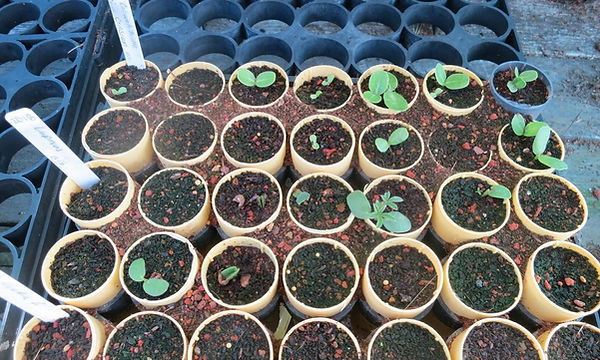
California Native Plant Society
in collaboration with East Bay Municipal Utility District
October 6, 2018
Dear Skyliners,
We've had a big couple of weeks, and very busy. The best news is we've completed the first clearing of Scattergrass in the Bay Groves along the south ridge - all the way down to Hwy 24. In the last month, we've cleared two more big groves, and when we went down to survey the last remaining grove on the ridge, we found there was no Scattergrass there at all. Hallelujah!! This is a really huge milestone.
Last Sunday, we cut and raked a long "negative Mohawk" from the Saddle through that bowl to the brush at the west. We will test vinegar on the thistles there to see if the mowing and raking is worth the extra effort. We shall see about that. And, we found a good deer trail that will give easier access to the big, Roller Coaster Slope that overlooks the Tunnel. Soon, we hope to get to work out there, too.
We'll be going out regular days for all of October: Sunday mornings at 9:30 and Thursday afternoons at 4 (until standard time returns). Please let me know if you can make it.
The seedlings in our little nursery are growing great guns. Here's a flat mixed with Wild Rye and Sticky Monkey:

Wild Rye is to the left and Sticky Monkey to the right. Sticky Monkey seed is fine as dust and look -- there must be several hundred of them there. These little ones are about three weeks old. It's now time to prick some of them out into larger containers.
Here's two shots showing how quickly others are growing. The first shot is from Sept 19, two weeks ago:

In the front rows are small seedlings of Silver Lupine (Lupinus albifrons) showing a first few true leaves. In the back rows are seedling Cobweb Thistle (Cirsium occidentale). These are mostly at the 'seed leaf' stage. Don't they look a lot like little sunflowers? They should, they are closely related.
This shot is from Oct. 4, two weeks later:

My, oh, my - how they have grown! Several true leaves on each Lupine now; Thistles are now sprouted in every tube and some with two or more true leaves. It is so satisfying to see such strong growth in such a short time. This is why we plant native perennials in late August - to take advantage of the warm growing months of September and October.
Meanwhile, out in the field, there's still a lot blooming. I wanted to feature two very different plants from the same genus, Epilobium. They are both members of the Evening Primrose Family, or the Onagraceae.
The first is the slender and wiry Willow Herb, Epilobium brachycarpum. Here's a group of them:

These are about three feet tall, with the most slender of stems and hardly any leaves. You will often find them at this time of year on east slopes, often near Yampah, on deeper soil that must provide the tiny bit of moisture they need.
Here's a close up of the flowers:

The largest flower is the size of a dime. These are annuals who wait till the end of the dry season to step forth and shine.
Here's their big cousins, the California Fuchsias, Epilobium canum, along Grizzly Peak Blvd:

These are perennials, and very showy plants in the field and in the garden. This Grizzly Peak patch is one of the best around, and they all have a lot more red in the flowers than you often find. This whole patch appears to be one large, old, clonal patch.
How different these two Epilobiums appear in flower and form - the Willow Herbs and the Fuchsias - yet in their essentials and genetics, they are closely related and in the same genus.
Not to be outdone, these last few weeks have been Aster Time. Here's a clump along the trail near Steam Trains:

These are perennials, too. California Aster comes in a zillion different forms, from tall spikes with small flowers, many shades of lavender and blue; sometimes even pure white. These are tough perennials, long lived in the wild and in the wild garden, too. The bees just love them.
Happy Trails,
Glen